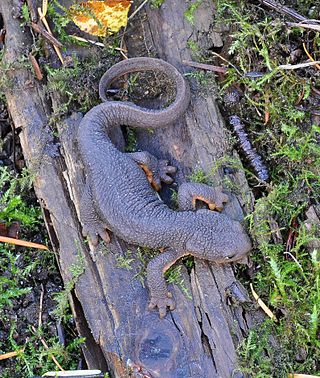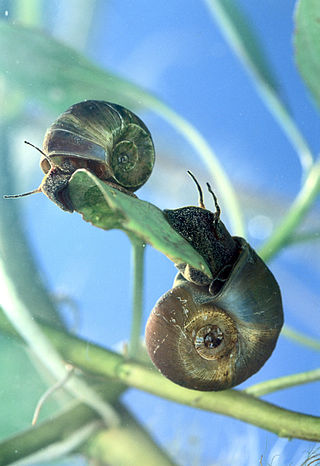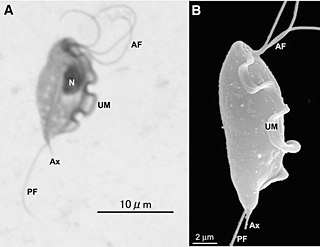
Sanders County is a county in the U.S. state of Montana. As of the 2020 census, the population was 12,400. Its county seat is Thompson Falls. The county was founded in 1905.

In anatomy, the palatine bones are two irregular bones of the facial skeleton in many animal species, located above the uvula in the throat. Together with the maxilla, they comprise the hard palate.

Salamandridae is a family of salamanders consisting of true salamanders and newts. Salamandrids are distinguished from other salamanders by the lack of rib or costal grooves along the sides of their bodies and by their rough skin. Their skin is very granular because of the number of poison glands. They also lack nasolabial grooves. Most species of Salamandridae have moveable eyelids but lack lacrimal glands.

Gravina Island is an island in the Gravina Islands of the Alexander Archipelago in southeastern Alaska. It is 21 miles (34 km) long and about 9.5 miles (15.3 km) wide, with a land area of 94.81 square miles (245.6 km2). The island had a population of 50 people at the 2000 census.

The Siskiyou Mountains salamander, also called the Siskiyou Mountain salamander, exists only in isolated locations along the Klamath River in northern California and southern Oregon. It is a close relative of the Del Norte salamander, and some herpetologists believe it may be a subspecies of that animal.

The genus Taricha consists of four species of highly toxic newts in the family Salamandridae. Their common name is Pacific newts, sometimes also western newts or roughskin newts. The four species within this genus are the California newt, the rough-skinned newt, the red-bellied newt, and the sierra newt, all of which are found on the Pacific coastal region from southern Alaska to southern California, with one species possibly ranging into northern Baja California, Mexico.

The rough-skinned newt or roughskin newt is a North American newt known for the strong toxin exuded from its skin.

The California newt or orange-bellied newt, is a species of newt endemic to California, in the Western United States. Its adult length can range from 5 to 8 in. Its skin produces the potent toxin tetrodotoxin.

The Mount Jefferson Wilderness is a wilderness area located on and around Mount Jefferson in the central Cascade Range of Oregon in the United States. The wilderness lies within the Willamette National Forest and Deschutes National Forest. The wilderness area covers 111,177 acres (449.92 km2), with more than 150 lakes. It also has 190 miles (310 km) of trails, including 40 miles (64 km) of the Pacific Crest National Scenic Trail. Three Fingered Jack and Mount Jefferson are both prominent features of the wilderness area. Mount Jefferson Wilderness is the second most visited Oregon wilderness area after the Three Sisters Wilderness.

The Sierra newt is a newt found west of the Sierra Nevada, from Shasta county to Tulare County, in California, Western North America.

Planorbella is a genus of freshwater air-breathing snails, aquatic pulmonate gastropod mollusks in the family Planorbidae, the ram's horn snails, or planorbids, which all have sinistral, or left-coiling, shells.
The Tulameen River is a tributary of the Similkameen River in the Canadian province of British Columbia. The Tulameen River is part of the Columbia River drainage basin, being a tributary of the Similkameen River, which flows into the Okanagan River, which flows into the Columbia River.

A newt is a salamander in the subfamily Pleurodelinae. The terrestrial juvenile phase is called an eft. Unlike other members of the family Salamandridae, newts are semiaquatic, alternating between aquatic and terrestrial habitats. Not all aquatic salamanders are considered newts, however. More than 100 known species of newts are found in North America, Europe, North Africa and Asia. Newts metamorphose through three distinct developmental life stages: aquatic larva, terrestrial juvenile (eft), and adult. Adult newts have lizard-like bodies and return to the water every year to breed, otherwise living in humid, cover-rich land habitats.

A nuptial pad is a secondary sex characteristic present on some mature male frogs and salamanders. Triggered by androgen hormones, this breeding gland appears as a spiked epithelial swelling on the forearm and prepollex that aids with grip, which is used primarily by males to grasp females during amplexus. They can also be used in male–male combat in some species.
Cephalouterina is a genus of trematodes within the family Lecithodendriidae under the order Plagiorchiida. Individuals of this genus are known to use amphibian hosts.
Cephalouterina decamptodoni is a species of trematodes within the family Lecithodendriidae under the order Plagiorchiida. This species is sometimes known to use amphibian hosts.

Tritrichomonas is a genus of single celled flagellated parasitic excavates, some of whose species are known to be pathogens of the bovine reproductive tract as well as the intestinal tract of felines.
Cosmocercoides is a genus of nematode within the order Ascaridida. Nematodes within the genus Cosmocercoides have been found as parasites within the rough-skinned newt, Taricha granulosa. Cosmocercoides includes the following species:

Marion Lake is a subalpine lake located in Linn County of the U.S. state of Oregon. The lake is in central Oregon's Cascades within the Mount Jefferson Wilderness. The lake is approximately 300 acres (1.2 km2), at an elevation of 4,134 feet (1,260 m).

The Bedded Range is a mountain range in the Hozameen Range subdivision of the Canadian Cascades, which are the extension of the Cascade Range into British Columbia, Canada. Located between the Coquihalla and Tulameen Rivers, the Bedded Range is a dioritic plug related to the Chilliwack batholith.















